Posted July 31, 2023
In nearly every college essay, the dealbreaker question amounts to: “What are you passionate about?”
With competitive admissions, but more pressingly, a price tag of an average $36,000 a year, college is a financial risk you must think wisely about. Without family financial backing or guarantee of a high-paying job, you risk financial ruin after graduation, caused by student debt that has left 54% of American college students and graduates feeling defeated and depressed
At 17, I knew that my answer to “What are you passionate about” could not only help me compete for the scholarships I needed to attend university, but the answer would be my north star in understanding exactly why I wanted a college education.
In response, friends and family panicked. They shouted, “You’re throwing your future away” at the thought of a gap year – I just ignored them and didn’t make eye contact.
Taking A Gap Year: Are You Throwing Your Future Away?
Despite disapprovals, I took a gap year — actually, three of them. With my new found freedom, I allowed my curiosity to guide me, and soon my attention fell on El Paso. By the summer after graduation, my hometown made headlines with “Children in cages” and “Site of our nation’s sixth largest mass shooting.” I listened to how the word “border” transformed into a limit, a boundary, a means to keep people out – a constant reminder of “otherness.” So, I packed my bags and returned to Texas.
My grandmother still lived in El Paso, and she graciously let me live with her as I figured out next steps.
When I first arrived I told myself this: Work a job you may not like just so you can have money. Then spend the rest of the time you have, doing something you love, that will eventually make you money.
So I hit the ground running. I juggled several different volunteer positions in the community, built connections with activists of all different ages, and slowly started discovering my interest in creative media. To make money, I worked a not-so-great gym job on that wonderful Texas minimum wage of $7.25 an hour. Eventually though, volunteering for a local non-profit for the past two months, and teaching myself video editing and graphic design led to a full-time job in work I was passionate about. For the next two years, I stayed in El Paso serving as a videographer, graphic designer and photographer for an immigration organization. Attorneys, advocates and asylum seekers from all over the world came to this crossing, and I documented the scenes that unfolded. My passion for storytelling developed as a means to dive deeper in documenting the world around me. I made a short film for PBS El Paso, landed my first personal documentary into a film festival over the sudden passing of my beloved father and captured the historic Black Lives Matter march on the steps of the Lincoln Memorial.
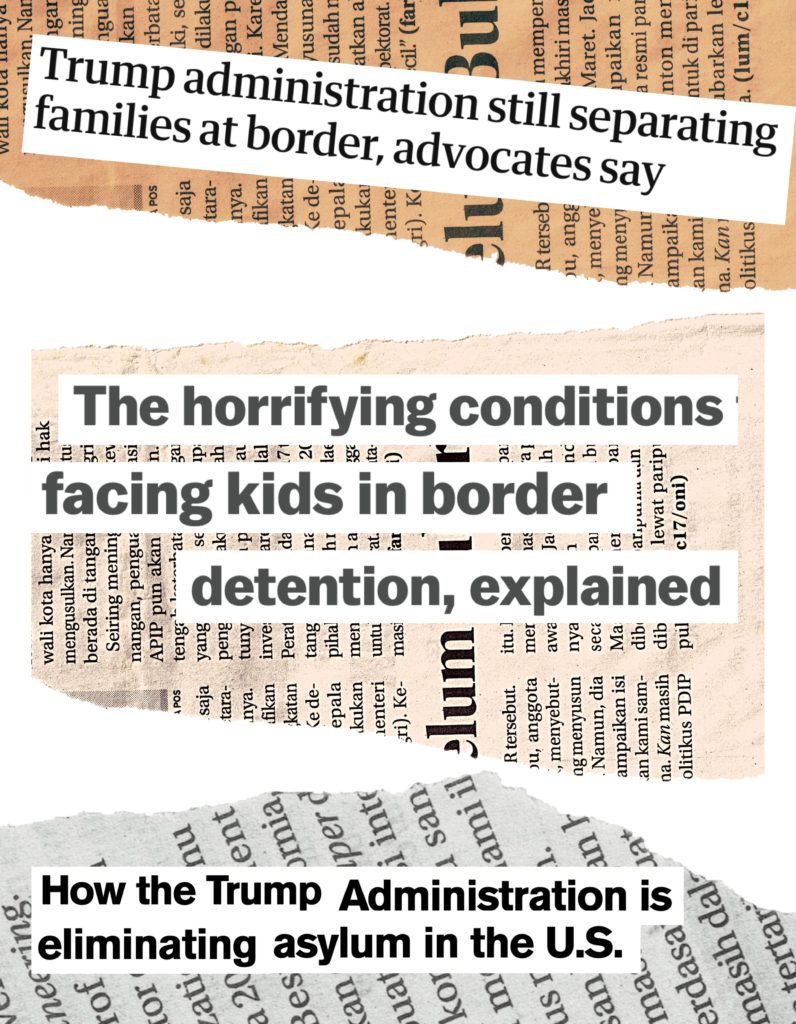
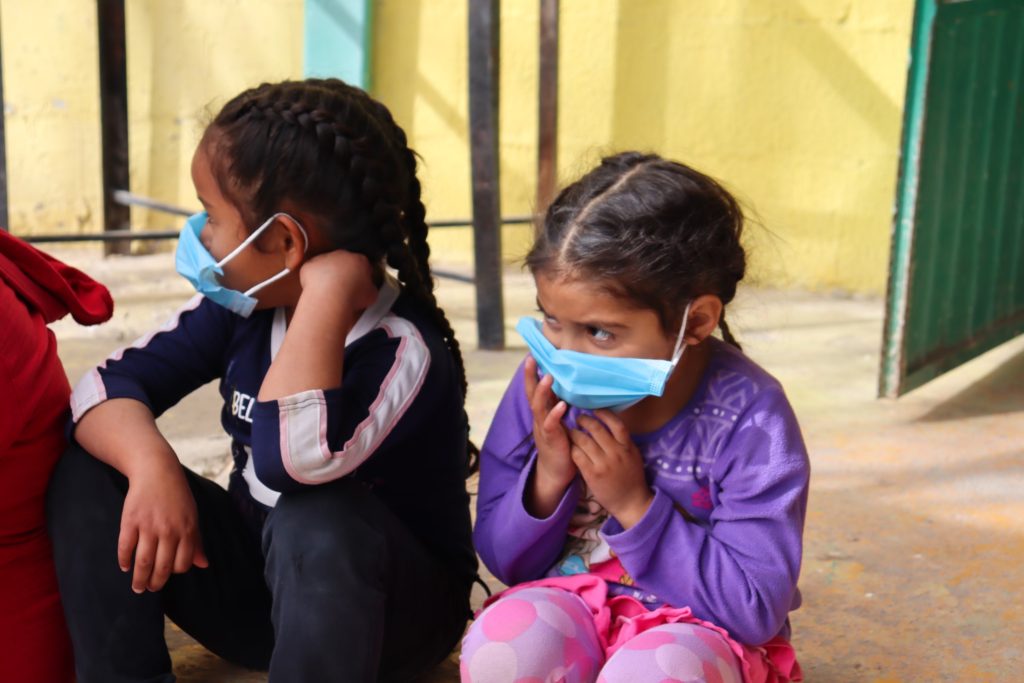
Little girls in a shelter in Juarez, Mexico amidst the Covid-19 pandemic
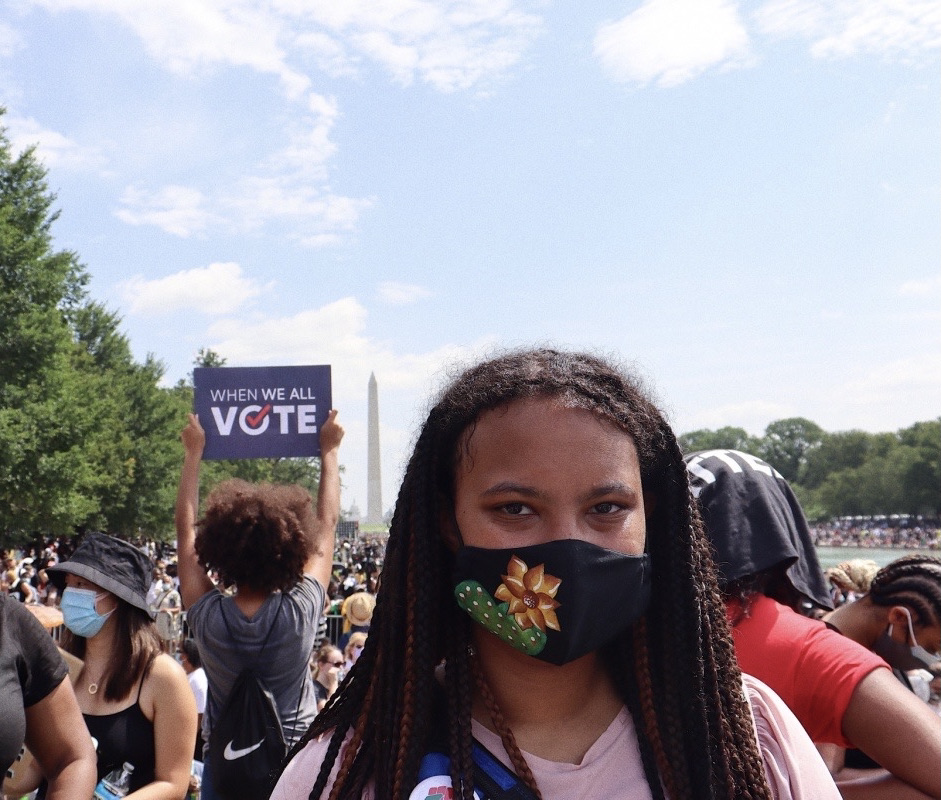
Capturing The Black Lives Matter March in Washington,DC 2020
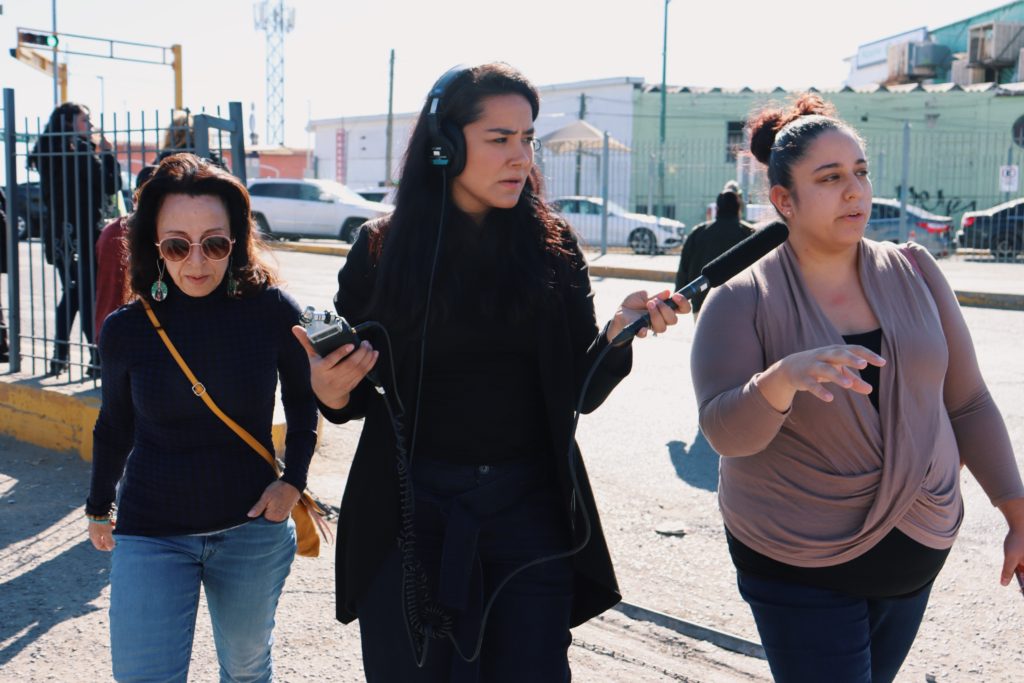
Reporter Maria Hinojosa from NPR’s Latino USA speaking with Las Americas Executive Director, Linda Rivas, regarding the powerful story of our client – a mother and daughter who are subject to the Trump administration’s border policies forcing them into ongoing violence.
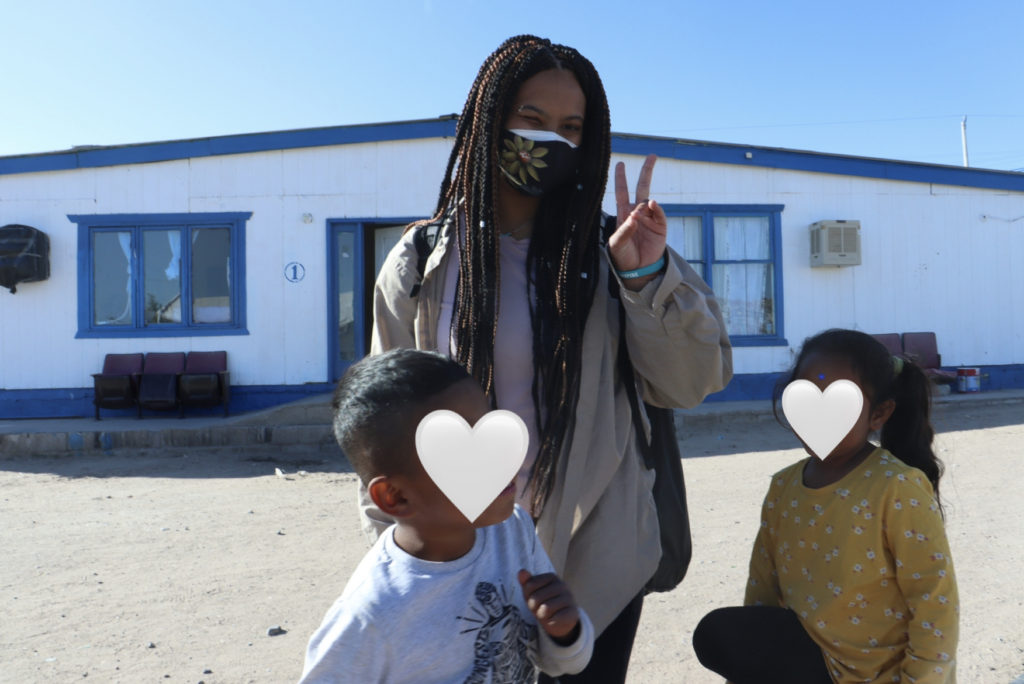
Playing with the kids in a Juarez shelter. I gave one little boy my camera to practice taking photos with
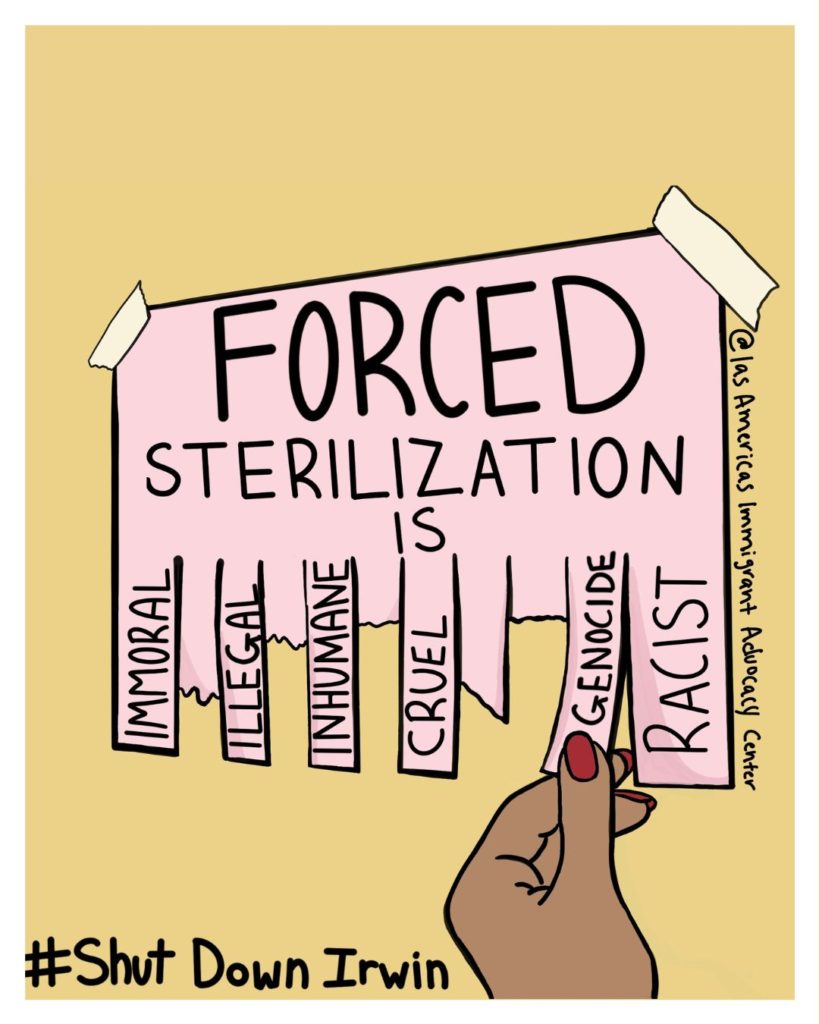
Graphic Design over the whistleblower case in Georgia where women inside the Irwin County Detention Center were being forcibly sterilized as they underwent hysterectomies without their consent. Nurse Dawn Wooten thankfully filed a complaint leading to the break of this story.
Remembering the life, legacy and love for my dad, Frank Censale. Shown in the El Paso Film Festival
At this point, I stopped using the term “gap year” because I had no intention to go to college. I was just now learning about myself and my love for film, creating art, speaking new languages – I loved exactly where my life was at this point. On top of that, the pandemic hit, so school wasn’t even school. There was so much more to explore and Germany was my next destination.
Through the U.S. State Department and German Government, I received the Congress Bundestag Youth Exchange (CBYX) Fellowship for Young Professionals to spend the next year in Germany. I was considered a “youth ambassador” and was enrolled in an intensive language school to learn German, taking a semester of classes at a university. But mainly, my fellowship had focused me on an internship in my field.

My 82 year old running buddy Horst. Read more about our funny friendship, here

Eating Berliners in Köln, Germany during my first month on the Congress Bundestag Youth Exchange Fellowship
Having witnessed repressive U.S. immigration policies, I was curious about the treatment of migrants in other parts of the world. I started working for a search and rescue boat that brought me to the Greek island of Lesvos. We captured stories of Afghan, Syrian, and African asylum seekers stranded at a camp known as New Moria.
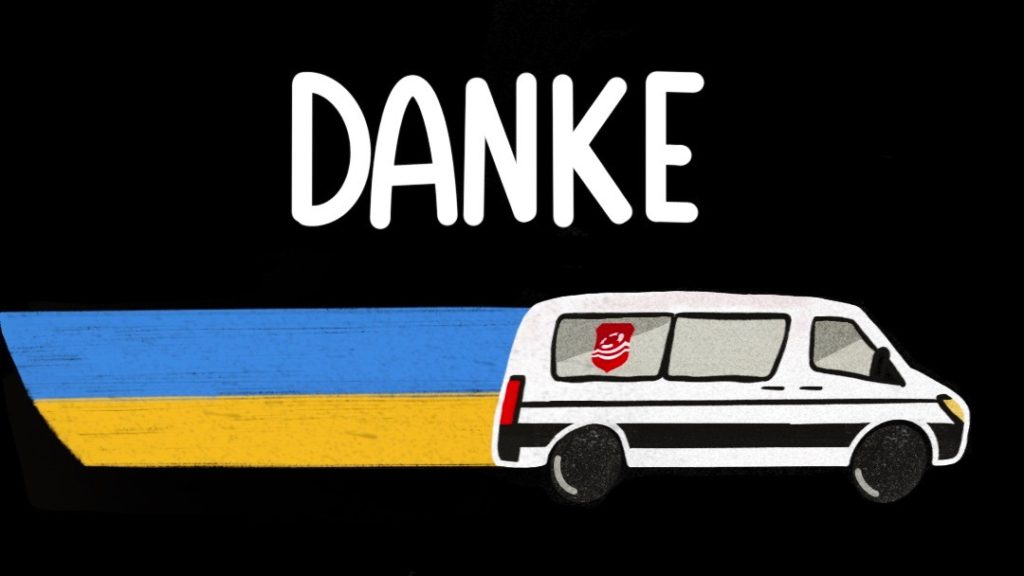
During our time in Greece, the Ukraine war had just begun. Mission Lifeline had started deploying aid to the Polish border. I created this graphic design for thanking donors in their aid towards Ukraine.

Protests in Berlin against Putin’s invasion of Ukraine. Read my post about disparities in refugee treatment I witnessed while in Europe.
My time with Mission Lifeline, took me to the island of Lesvos where we documented what the refugee camp Moria looked like 2 years after the fire. Read more about my time with Mission Lifeline here

Graphic designs for donation website
During my gap years, I also took a few community college classes for fun to learn what I liked and what I didn’t like so I could better plan for my degree at a four year-university in the future.
After a year of crossing paths with amazing people, traveling to 12 countries, becoming conversational in another language and gaining a whole new set of perspectives – something clicked. I wanted to go to college.
But…it wasn’t that easy.
Gap Years Prepared Me For The Future, But Not For The Headache Of College Admissions
These gap year experiences provided me with direction and helped me grow as a person in ways that attending college straight out of high school would have never done.
Taking time off encouraged work and life experiences that helped me compete for the scholarships I needed to attend university. But as I soon learned during this application process, there are steep consequences to deviating from the high-school-to-college-pipeline that no one talks about.
At 21, I understand why college is important for my future. But for students like me seeking a degree after time away, the roadblocks can be incredibly discouraging.
Community College Credits Can Count Against You
Having returned from Germany, I was staying in the dorms of American University for a closing seminar with my fellowship cohort. Growing fond of DC over the years, I thought attending school here would be a great opportunity. So I decided to take a tour of AU – and this is where everything started to take a turn for the worse.
When the tour was over, I stayed after to speak to an admissions officer. I inquired about the full ride freshmen scholarships and additional scholarships available. I then mentioned briefly how I took some community college classes while I was living in El Paso and she cut me off. She corrected me saying that I wouldn’t be applying as a freshman applicant to their university but rather a transfer student.
“If you take even one college class after high school then you’re considered a transfer student for our university.” The admissions officer stated.
“Ok does that matter?” I asked.
“Well,” she says, “as a transfer applicant you are ineligible for all freshmen full ride scholarships because you are a transfer student and not a freshmen student.”
“Are there any full ride transfer scholarships?”
“Unfortunately, no.”
“I only took 3 classes, that’s only 9 credits, can you take them away from me? I don’t want them if they’re preventing me from applying to your scholarships.”
“You can’t, you have to keep them.”
“What if I don’t declare them?”
“We’ll know because they’re on a national registry.”
Since when does taking one college class after high school make you a transfer student? Most importantly, why are you not allowed to forgo the very credits that are preventing you from applying to scholarships? Why was I being penalized for going to school?
I thought maybe this is just an American University rule until I started calling and emailing the roster of all the potential colleges I wanted to apply to.

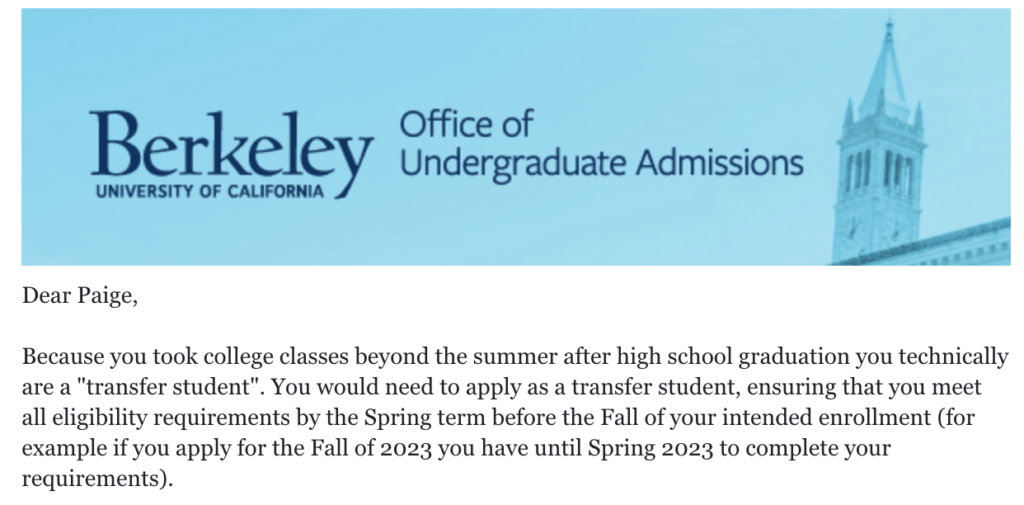
“You are considered a freshman applicant if you are still in high school or you have graduated from high school but have not enrolled in a regular session at any college or university,” said UCLA.
“Because you took college classes beyond the summer after high school graduation you technically are a ‘transfer student,’” said UC Berkeley
“Since you completed college courses after high school, you would be considered a transfer applicant and want to complete our transfer student application,” said University of Washington.
All the same answers also came from Western Washington University, NYU, George Washington University, Seattle University, Stanford and others.
Not only did being labeled as a transfer student mean that I was ineligible to apply for full ride freshmen scholarships, I would now be offered less financial aid than my freshman applicant peers.
“At first I thought maybe being a transfer student is better for me because of the favorable admissions rate to the colleges I wanted to apply to, but then I realized the financial aid is terrible,” said Ángel García Donjuán, a University of North Texas transfer student I met while living in Germany. Ángel, had similar problems and has spent the past year advocating for awareness of these issues.

Ángel García Doniuán testifying before the Texas State Senate Higher Education Subcommitteeon March 23, 2023, in support of Senate Bill 2539 (SB 2539) . Garcia Donjuan is a member of the Student Advisory Council, a program organized and supported by The Education Trust in Texas, Young Invincibles, Every Texan, and Breakthrough Central Texas as a joint initiative of the Texas Postsecondary Advocates Coalition for Equity (TX PACE).
IMPORTANT: Ángel García Donjuán highlights how access to dual credit positively impacted his college and career trajectory and is another pathway towards higher education. However, do note, you are only considered a transfer student if you take community college AFTER high school not DURING (why that makes sense, I don’t know). Meaning that while Ángel was exempt from these financial aid problems as a recent high school grad with dual credit, the minute he took community college classes POST high school, triggered him to being officially labeled as a transfer student due to that “one credit post high school” rule that many colleges have. Being a transfer student automatically qualifies you for less scholarships and financial aid than freshmen but it’s still financially wiser in many ways if you don’t have significant scholarships to cover your whole four years at a university.
“The weight of my application was placed on my community college GPA and admissions didn’t always ask for essays to explain my valuable gap year experiences,” Ángel said. “I wish institutions looked at transfer students more holistically like they do with freshmen applicants and offered a wider range of financial aid and scholarship opportunities. Not enough responsibility is placed on the institutions’ end to accommodate diverse educational backgrounds.”
FAFSA, which stands for Free Application for Federal Student Aid, is what the US government uses to determine a college student’s eligibility for federal aid. That aid includes the Pell Grant, which is a way to support low-income students in financing college. An article by Inside Higher Ed states, “While technically eligible for aid, they [transfer students] are not prioritized by institutions and are frequently placed at the end of the long line of eligible students. Many institutions prioritize aid for first-year freshmen, or for existing students who have earned special distinctions and are awarded aid by faculty or departments. The unintended consequence is that transfer students — many of whom are now facing higher tuition at a university than they paid at their community college — do not receive state aid, even when they have demonstrated need and meet all eligibility requirements.”
Falling into a transfer applicant status for simply taking a few random classes makes it more difficult for low income students, like myself, to continue pursuing higher education. For students on a nontraditional path to degrees, this deceptive classification feels punitive.
I tried to calm myself down after learning this and assured myself that I could just cover the cost by applying for a lot of external scholarships…right? Wrong.
Nontraditional Students Struggle To Find External Scholarships
Full rides for any student are certainly few and far between, but especially for transfers. I thought more renowned scholarships offered by sources like Coca Cola, or local, smaller scholarship funds could help subsidize tuition costs that the federal student aid program did not cover.
As I read into many external scholarship guidelines, I kept encountering the phrase “must be either a high school senior or currently enrolled in college.” But I was neither. The gap years put me into a financial aid gray area where hardly any large scholarships allowed me to apply.
Faith Austin, who recently finished her gap year on the CBYX Youth Program hit similar roadblocks in her college application process, “For a couple of the scholarships I applied for, I realized I was ineligible. I had to be directly referred to by my high school and I was no longer affiliated with my high school because I graduated,” she said.
Faith and Ángel are like many students who chose to take a gap year as a means to be financially strategic about their college education since they weren’t going to receive full financial backing from their parents, “It will totally be a deal breaker if I don’t get scholarships to attend university.” Said Faith. “If I were going to my state school of Indiana University Bloomington and I was planning on double majoring, even with my general education credits already out of the way because of the courses I took in high school, the in-state tuition is $27,000 a year when factoring in room and board.”
As tuition rates continue to increase, minimum wage remains stagnant. Indiana’s minimum wage is $7.15 an hour, making it impossible to take the old fashioned, pay-your-way-through-college route. Financial barriers like this ultimately force gap year applicants into committing to debt first and seeking scholarships later.
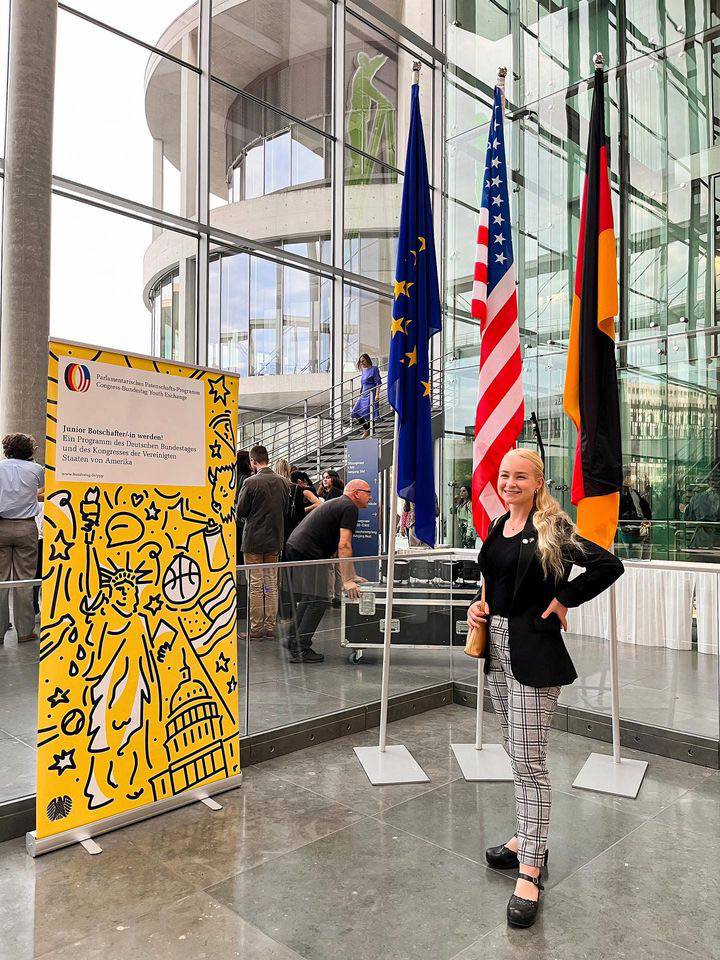
Faith Austin at the Bundestag in Berlin, Germany during her CBYX Fellowship. Read more about her exciting gap year in Germany on her Instagram.
Gap Year Students Are On Their Own
As a gap year student, I didn’t have access to guidance counselors or other school staff to help me with my application. Rather I was left alone to understand a much more complicated system. “The answers are not just out there and there isn’t just a place you can go to,” said Ángel, who was frustrated to discover another “unspoken rule” in this application process. Despite being several years out of high school, gap year students are forced to return to our former stomping ground for mandatory items such as teacher recommendations, transcripts, and waivers for hefty application fees.
While we didn’t talk regularly, I still ended high school on good terms with many high school teachers. So, when I sat them down for a PowerPoint about the last three years of my life, it wasn’t awkward and they were happy to help. Staying in touch with my former guidance counselors, algebra and marketing teachers, luckily made this process pleasant. If I hadn’t had good relationships with staff, I might have been forced to submit dull and outdated recommendations, or struggled to get them at all.
My Alternative Route: Finish The Community College Credits I Started
For the next two months I pulled my hair out trying to find a way around this. I called, emailed and scoured the websites of nearly every college in the country. My hope was to find at least one institution that didn’t care about my community college credits so I could apply as a freshman applicant and avoid the financial barriers associated with being a transfer applicant. When the dust settled, I took a step back and was satisfied that my list consisted of ten universities…but a nervous knot appeared when eight of them were Ivy Leagues.
While these institutions offer flexible gap year eligibility for financial aid and scholarships, first you must be accepted to these incredibly competitive colleges. I held my breath and still applied, keeping close a back-up plan: I would finish my associate’s degree at community college on financial aid and seek scholarships to transfer to a four-year in-state institution. In fact, that’s what California native, Cassidy Rae, did.
“I started at a community college in California and after receiving my AA, I transferred to the University of California, Los Angeles (UCLA). At UCLA, I was very fortunate to have qualified for their Blue and Gold plan which covers the full cost of tuition and fees,” said Cassidy.
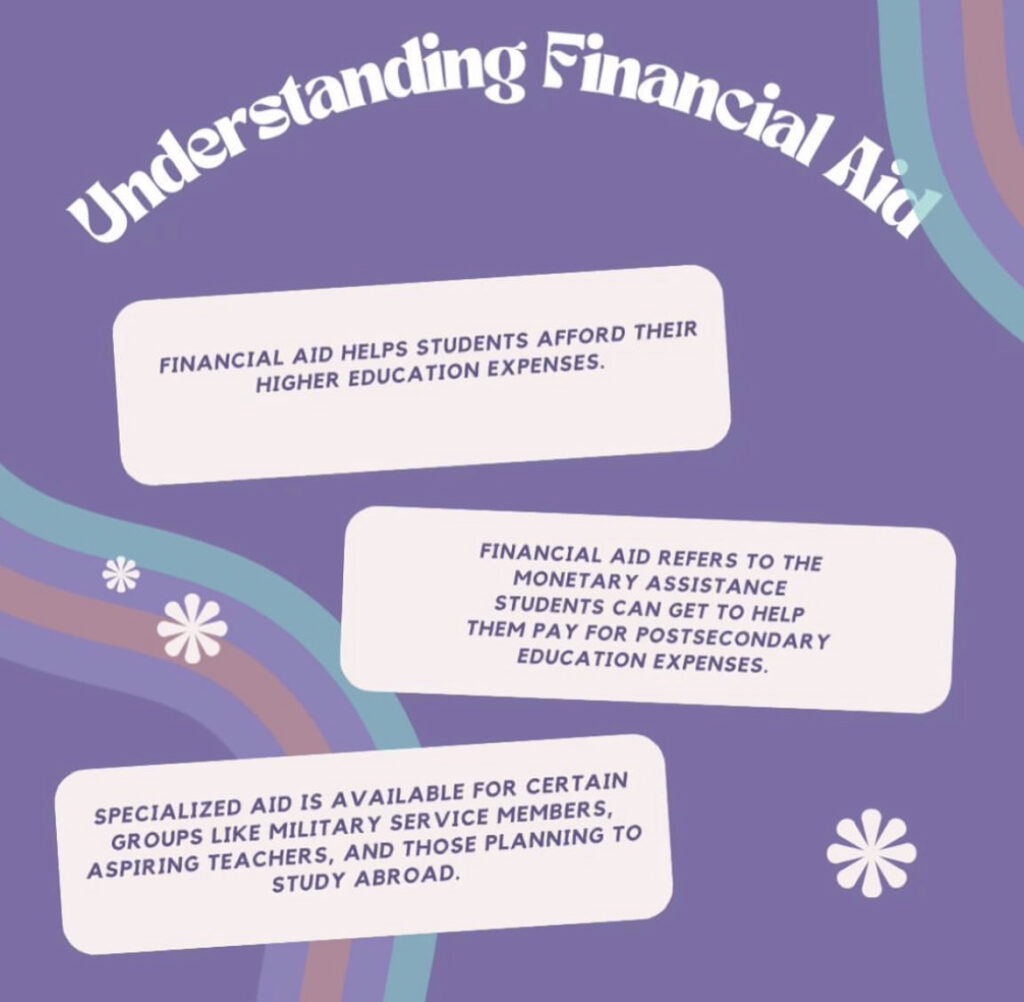
Cassidy’s Instagram page provides resources for transfer students to understand what is ahead in their college journey.
As a recent graduate, she runs a TikTok account dedicated towards erasing the stigma around community college and breaking down how to attend higher education with little to no loans.
Cassidy said, “Being a community college student definitely helped me pay for the cost of college! As long as you transfer to an in-state 4-year university, your attendance is very affordable through scholarships you can find through your community college.”
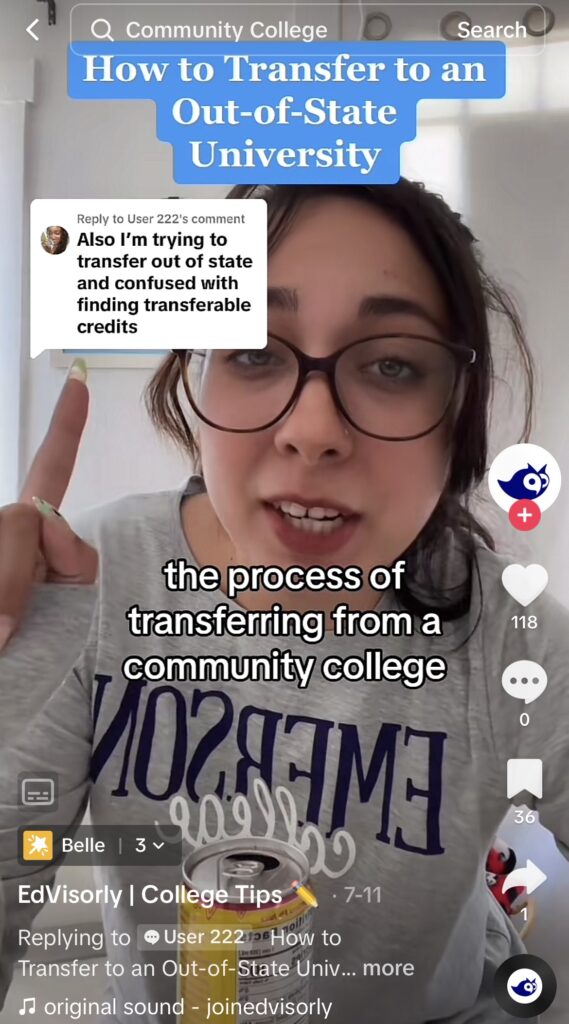
Cassidy explaining the complexities of transferring to college as a community college student via her TikTok page
Gap Years Saved My Future
Soon, things got easier. I knew exactly where I could apply as a freshman and thus what scholarships I qualified for to help subsidize the cost of tuition. Simultaneously, I had my back up plan of attending community college and trusted that my future self would find the scholarships to pay the remaining transfer student loans off, since I would qualify for more of them as a matriculated student.
In my applications, I explained how my gap year adventures ignited my passion for studying film and international relations. I applied to four universities and this March was accepted by three, offered a substantial financial aid package by one, but my last acceptance letter awarded me a full ride. I will begin studying at Brown University this fall.
Two minute video portfolio used as part of my application to Brown University to share with them a short glimpse of who I was as an applicant
Between my gap years, and the community college credits, my full-ride freshmen admission is a rare privilege. I am incredibly grateful for this opportunity and for a school like Brown to have flexible financial aid opportunities for nontraditional students. However, as times change, outdated college admissions rules must change, too. Gap years will not disappear, in fact, in our post-COVID world, they are rising. But these classifications and financial aid barriers discourage nontraditional students. In an oversaturated job market, gap years can give students an edge in attaining valuable work experience, help college applicants stand out from the crowd, and encourage maturity.
Taking out massive loans to pay for a college education is a widely known part of our flawed American culture. However, being sharply penalized financially over and over again when gap year students like me simply want to take time to explore the world after high school – that is punitive and needs to be addressed.
Because of my gap years, I am entering college at nearly 22, but much more confident and prepared than I ever was at 17. Why wouldn’t the U.S. education system want more students to feel like this?
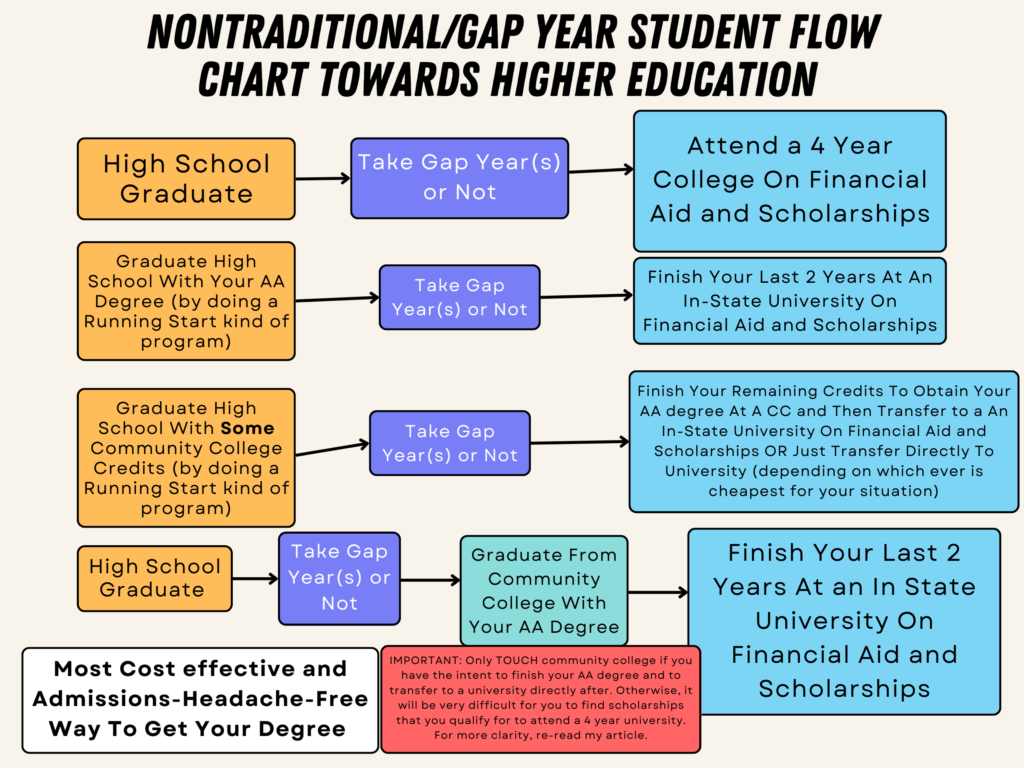
My flow chart for the most cost-effective way to get your degree if you are, or planning to become, a nontraditional student
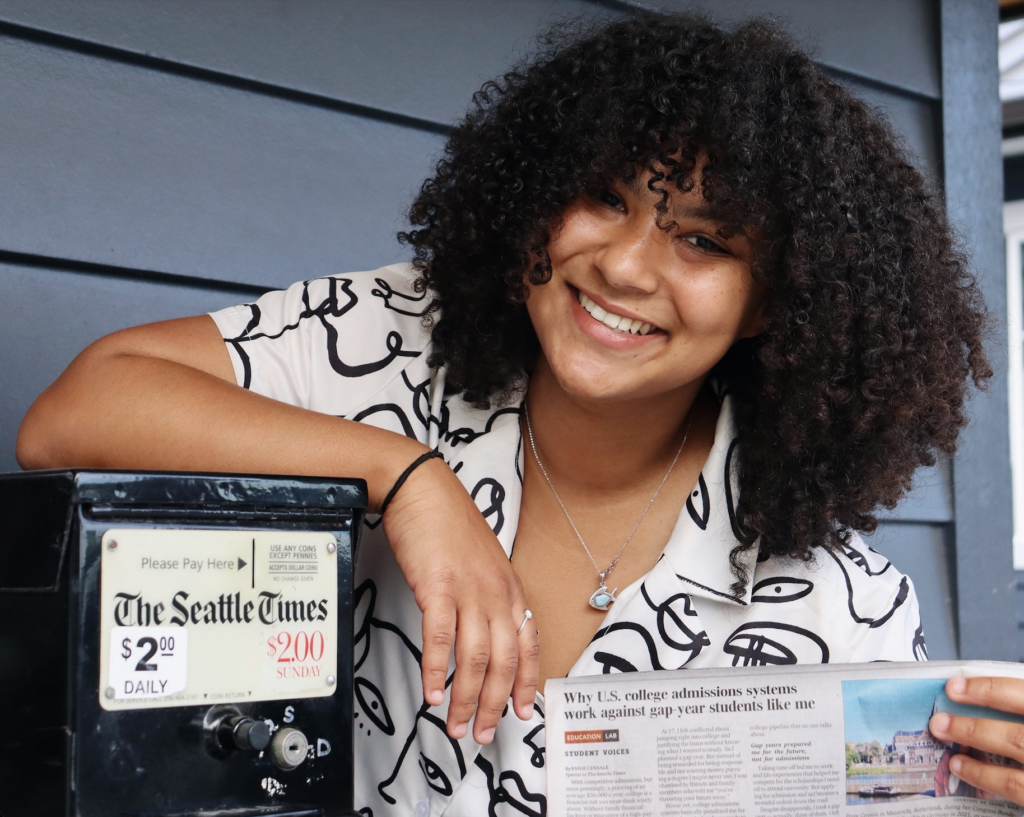
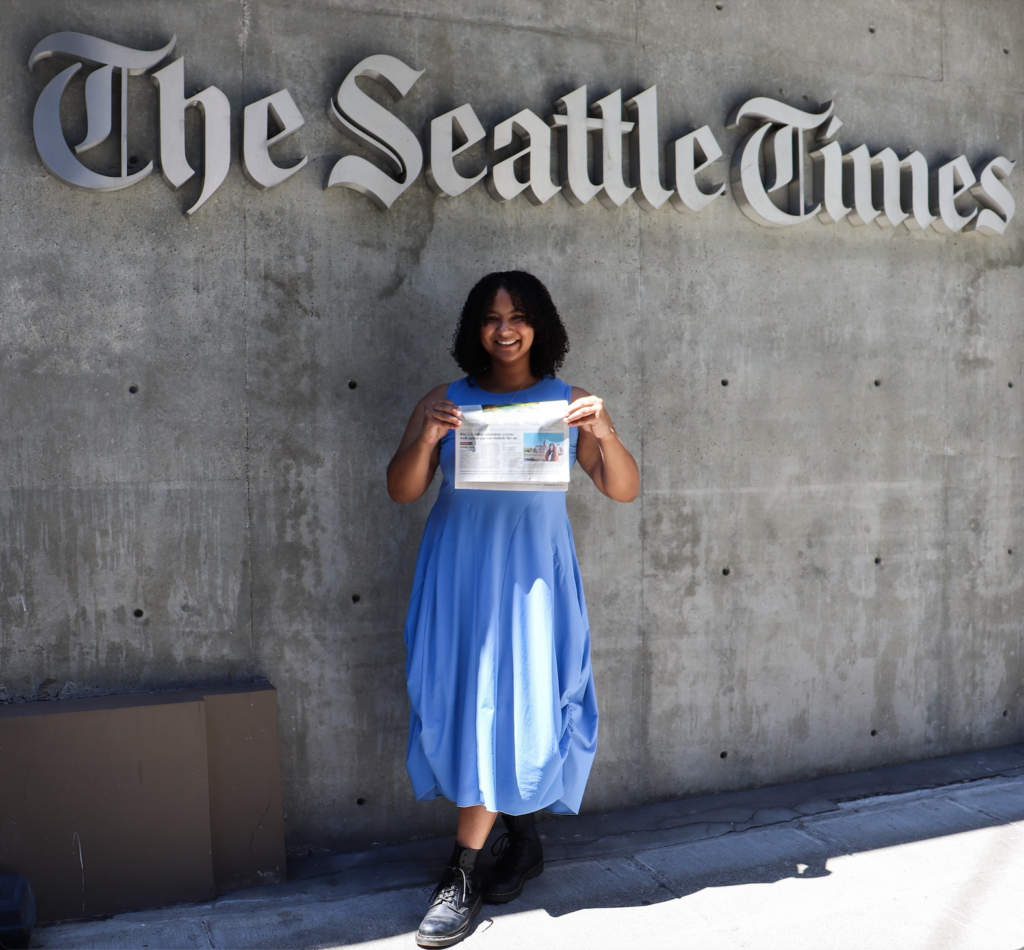
This blog post is an extended version of my article published in the Seattle Times on July 23, 2023. If any of this was informative and you would like to leave a comment, feel free to tell me via the contact form. Thank you for reading!
